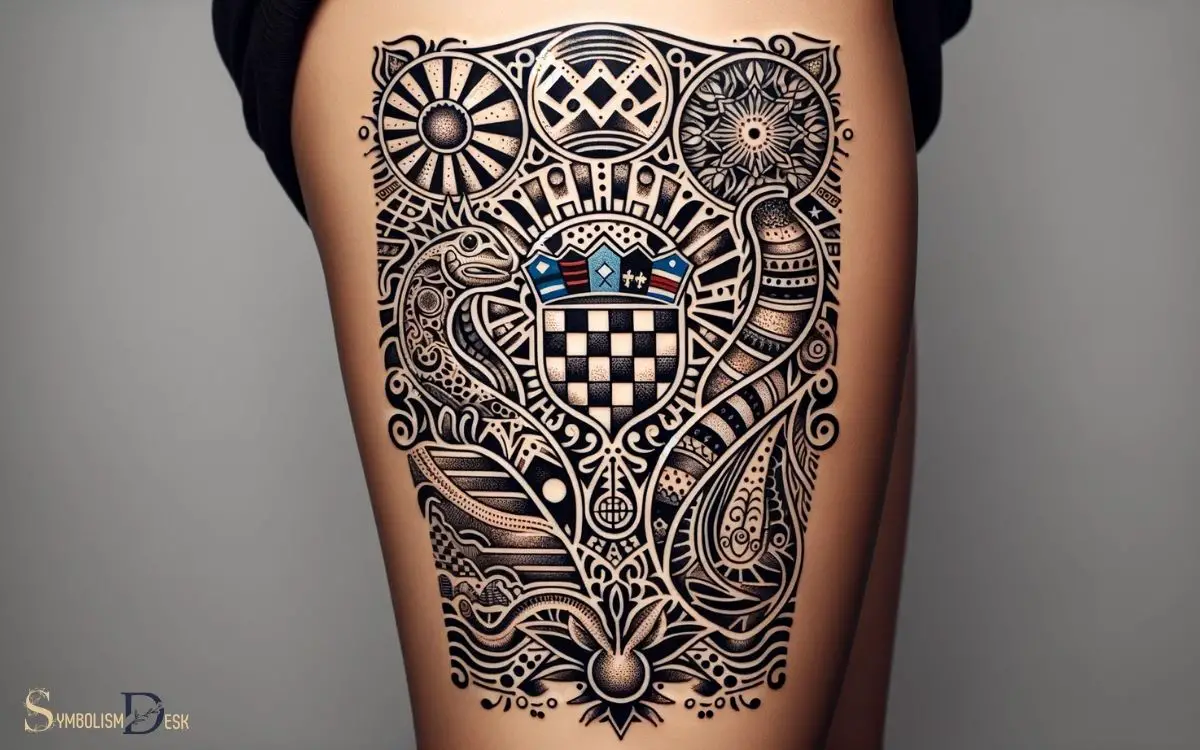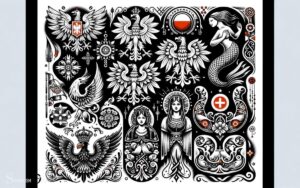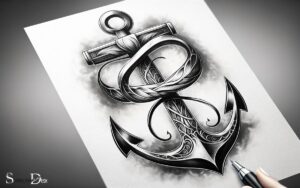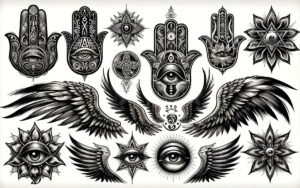Croatian Tattoo Symbols and Meanings: Explain!
Delve into the captivating realm of Croatian tattoo symbols, each imbued with historical and cultural significance. These tattoos offer a window into the soul of Croatia, showcasing motifs from the ancient Slavic heritage to modern designs that pay homage to tradition.
Common symbols include the checkerboard or ‘šahovnica’, which is a national emblem, traditional Glagolitic script, and various representations of nature and wildlife, all holding distinct meanings and symbolizing the country’s rich history and cultural identity.
Croatian tattoo symbols are deeply rooted in the country’s past, often reflecting the importance of history, nature, and spirituality.
For example:
- The checkerboard pattern, known as ‘šahovnica’, symbolizes national pride and history.
- Glagolitic script tattoos pay tribute to the oldest known Slavic alphabet, emphasizing the importance of language and knowledge.
- Animal motifs, such as the Croatian griffin or wolf, represent strength, freedom, and guidance.
- Nature symbols, like the oak or olive, signify resilience, peace, and longevity.
Each Croatian tattoo is a testament to the enduring spirit of the country, woven into a visual language of ink and skin.

Key Takeaway
Ancient Croatian Tattoo Symbols
Ancient Croatian tattoo symbols date back to the early civilizations of the region and hold significant cultural and historical importance. These symbols were deeply intertwined with the daily lives of the ancient Croatians, representing their beliefs, traditions, and cultural identity.
The interlacing patterns, known as pleter, were commonly used in Croatian tattoos and symbolized the interconnectedness of life and eternity. Animals like the bear, wolf, and deer held symbolic meaning, representing strength, loyalty, and freedom.
Additionally, ancient Croatian symbols often depicted natural elements such as the sun, moon, and water, reflecting the deep spiritual connection the Croatians had with nature.
These intricate and meaningful symbols not only adorned the bodies of the ancient Croatians but also served as a visual language, conveying their rich cultural heritage and beliefs to future generations.
Slavic Motifs and Their Meanings
Slavic culture incorporates a diverse array of motifs in Croatian tattoos, each carrying unique meanings and significance for the wearers.
These motifs often draw inspiration from nature, ancient symbols, and folklore, reflecting the deep-rooted traditions and beliefs of the Slavic people.
Below is a table showcasing some common Slavic motifs found in Croatian tattoos, along with their meanings:
| Motif | Meaning |
|---|---|
| Perun’s Axe | Represents the god of thunder and lightning |
| Zmijavci | Symbolizes protection and strength |
| Kolovrat | Signifies the cycle of life, death, and rebirth |
| Veles’ Knot | Represents the god of earth, waters, and the underworld |
Each motif holds significant cultural and spiritual importance, adding depth and personal significance to Croatian tattoos.
Transitioning into the subsequent section about ‘traditional Croatian tattoo designs’, these motifs continue to play a central role in the rich tapestry of Croatian tattoo art.
Traditional Croatian Tattoo Designs
Traditional Croatian tattoo designs encompass a wide range of symbols and patterns that hold deep cultural and historical significance. These designs often draw inspiration from Croatia’s rich heritage, including motifs from traditional folklore, mythology, and religious iconography.
One of the most prevalent traditional Croatian tattoo designs is the ‘šahovnica,’ or the checkerboard pattern, which is a symbol of Croatian unity and independence.
Additionally, motifs such as the ‘knot of love’ and the ‘Croatian interlace’ are popular choices, representing love, eternity, and interconnectedness.
Traditional Croatian flora and fauna, like the ‘Gryphon’ and the ‘Ala,’ are also commonly featured in tattoos, symbolizing strength, protection, and resilience.
Each design is steeped in cultural significance, making traditional Croatian tattoos a powerful way for individuals to connect with their heritage and express their pride in Croatian identity.
Sacred Symbolism in Croatian Tattoos
The incorporation of sacred symbols in Croatian tattoos reflects the deep spiritual and religious significance within Croatian culture.
One of the most prominent sacred symbols is the Croatian interlace, also known as the pleter. This interconnected pattern symbolizes the interconnectedness of life, eternity, and the never-ending cycle of birth and rebirth.
Another sacred symbol often seen in Croatian tattoos is the Glagolitic script, an ancient Slavic script used in religious texts. The use of this script in tattoos signifies a deep connection to Croatian religious traditions and history.
Additionally, the symbol of the Croatian chequy, a pattern of alternating squares, holds great historical and national significance, often representing the unity and strength of the Croatian people.
These sacred symbols in Croatian tattoos serve as a powerful expression of faith, heritage, and cultural identity.
Contemporary Interpretations of Croatian Symbols
Contemporary interpretations of Croatian symbols in tattoos reflect modern artistic expressions and their cultural relevance today.
As individuals continue to draw inspiration from Croatian heritage, these symbols take on new meanings and significance, representing a blend of tradition and contemporary perspectives.
The symbolism in Croatian tattoos serves as a powerful form of personal and cultural expression, bridging the past and the present.
Modern Artistic Expressions
Artists today incorporate Croatian symbols into their work to create modern interpretations with deep cultural significance.
These contemporary expressions often blend traditional Croatian motifs with modern artistic techniques, reflecting the evolving nature of Croatian culture and its enduring symbolism.
For instance, contemporary Croatian artists may use ancient Slavic symbols like the kolovrat or the triskele in their work, infusing them with new meanings and interpretations that resonate with present-day audiences.
By doing so, these artists contribute to the preservation and revitalization of Croatian heritage while also engaging in a dialogue with the broader artistic community.
Through their creations, they bridge the gap between the past and the present, offering a fresh perspective on Croatian symbols that speaks to the complexities of modern identity and cultural interconnectedness.
Cultural Relevance Today
Incorporating Croatian symbols into contemporary art allows for the exploration of cultural relevance and interpretation in modern contexts.
- Revival of Tradition: Many Croatian artists are integrating traditional symbols like the Croatian coat of arms or the interlace patterns into their work, sparking a renewed interest in the country’s cultural heritage.
- Social Commentary: Some contemporary Croatian artists use traditional symbols in their work to comment on current social or political issues, providing a bridge between the past and the present.
- Global Influence: Croatian symbols are gaining attention on the global stage, as they’re being used in international art exhibitions and collaborations, showcasing the enduring significance and appeal of these cultural emblems.
This contemporary reimagining of Croatian symbols serves to keep the country’s heritage alive and relevant in today’s world.
Transitioning from traditional art forms to modern expressions, incorporating these symbols into tattoos is a natural progression.
Symbolism in Tattoos
The reinterpretation of traditional Croatian symbols in contemporary tattoo art reflects a dynamic evolution of cultural heritage through the passage of time.
In modern tattoo designs, traditional Croatian symbols such as the interlace patterns, Croatian coat of arms, and Glagolitic script are often incorporated with a contemporary twist.
The interlace patterns, once found in ancient Croatian artifacts, are now reimagined with bolder lines and more intricate designs, representing the fusion of old and new.
The Croatian coat of arms, with its distinctive checkerboard design, is often stylized and adapted to fit different body placements.
Additionally, the Glagolitic script, an ancient Croatian script, is now used in tattoos to convey personal messages or to pay homage to Croatian linguistic heritage.
The contemporary interpretations of these symbols in tattoos showcase a deep respect for Croatian culture while embracing modern artistic expressions.
Significance of Animal and Nature Symbols
Many Croatian tattoo designs incorporate animal and nature symbols to convey deep cultural and spiritual significance.
Animal Symbols
- Animals like the bear and wolf represent strength, protection, and family.
- The falcon symbolizes freedom, vision, and guardianship.
- The horse signifies power, freedom, and nobility.
Nature Symbols
- The oak tree symbolizes longevity, strength, and endurance.
- The vine represents growth, fertility, and interconnectedness.
- The sun symbolizes life, fertility, and energy.
These symbols are deeply rooted in Croatian folklore and traditions, reflecting the connection between the people and the natural world.
Symbolic Representation of Croatian Heritage
Croatians often incorporate traditional symbols in their tattoos to honor and preserve their rich cultural heritage. These symbols are deeply rooted in Croatia’s history and traditions, representing aspects such as faith, family, and national pride.
The Croatian interlace, known as the pleter, is a prevalent symbol that reflects unity and continuity, often seen in tattoos as a representation of interconnectedness with Croatian roots.
Other symbols, such as the red-white checkerboard of the Croatian coat of arms, convey patriotism and allegiance to the country.
Additionally, the Glagolitic script, an ancient Slavic alphabet, is another popular choice, symbolizing linguistic heritage and the enduring spirit of Croatian identity.
Conclusion
Croatian tattoo symbols carry deep meanings and rich cultural heritage. While some may argue that these symbols are only relevant to Croatian culture, it’s important to recognize and appreciate the significance of diverse tattoo traditions. Furthermore, just as Croatian tattoo symbols hold deep meaning, so do polynesian tattoo symbols. Each element and design within polynesian tattooing has its own unique cultural significance and history. By embracing and understanding the significance of diverse tattoo traditions, we can appreciate the beauty and depth of tattoo art from various cultures.
Understanding the symbolism behind Croatian tattoo designs can provide a deeper appreciation for the art form and the cultural history it represents, enriching the experience for anyone interested in tattoos and their meanings.






